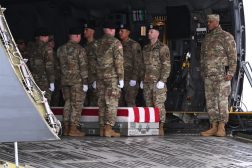US-UK joint strikes on Houthis targeted drones, missiles and radar

The U.S.- and U.K.-led strikes against Houthi-controlled areas in Yemen late Thursday involved more than 150 various munition types and targeted drones, weapons, radar and surveillance assets across nearly 30 precise locations, Director of the Joint Staff Lt. Gen. Douglas Sims II told reporters on Friday.
An official battle damage assessment is underway, but in a virtual press briefing on the operation, Sims emphasized that it “was not necessarily about casualties as much as it was about degrading capability” and technology the Iran-backed rebel group has been deploying to attack commercial ships in and around the Red Sea since the Israel-Hamas conflict started in October.
The Houthis’ assaults against multinational vessels further intensified this week, and on Thursday, the U.S. and U.K. (with support from the Netherlands, Canada, Bahrain and Australia) conducted what Sims said were strikes launched in self-defense based on an authority on hostile intent and a determination that all the systems would be used against the maritime or air forces of those involved.
“Every target we struck last night was associated with a capability that has been employed in denying freedom of navigation in the Red Sea and the [Bab-el-Mandeb Strait, or BAM]. So, whether it was associated with radars that are providing surveillance to the Houthis to determine what ships to strike at, if it’s one-way attack [unmanned aerial vehicles, or UAVs] that are being used to strike at ships or at some sort of missile — ballistic, cruise or otherwise — that have been employed in an effort to strike those ships: All of those were capabilities that we sought to degrade with our strike last night,” Sims said.
In a call with media Thursday night, a senior administration official also said the joint strikes carried out by the U.S. and U.K. went after targets “focused specifically on Houthi missile, radar and UAV capabilities — the capabilities that are essential to the Houthis’ campaign against commercial shipping in international waters.”
On Jan. 9, “nearly 20 drones and multiple missiles were launched in multiple salvos directly against U.S. ships,” the administration official said, adding that the attack was ultimately thwarted by U.S. and U.K. naval forces as part of the multinational Operation Prosperity Guardian.
During the call with reporters Friday, Sims made a point to note that the latest strikes were not conducted under the OPG initiative.
“The missiles that are being employed in some cases by the Houthis are not the most technical, and so they have the ability to strike multiple different locations just based on what they see at the time. And again, this wasn’t a U.S. action — this was a multinational action” in response to the Houthis ongoing aggression in the crucial international shipping routes, Sims said.
After the briefing Friday, a senior defense official who spoke to DefenseScoop on the condition of anonymity noted that even though the Houthis’ systems and weapons aren’t the most technologically advanced or high-end, if left undefended, they have been disruptive enough to interrupt significant international commerce.
“And it has warranted the response that got executed last night, one with significant firepower of a multi-pronged strike mission,” the senior official told DefenseScoop.
In 2016 an American destroyer shot Tomahawk cruise missiles at multiple Houthi-run radar sites along Yemen’s Red Sea coast in response to a flare-up of attacks.
The latest multinational strikes Thursday were not “retaliatory in a personal or a human impact kind of way — they were reducing the Houthis’ capability,” the senior defense official said.
“It’s similar to what was done in 2016. It’s just more extensive now because their capabilities have increased,” they added.






